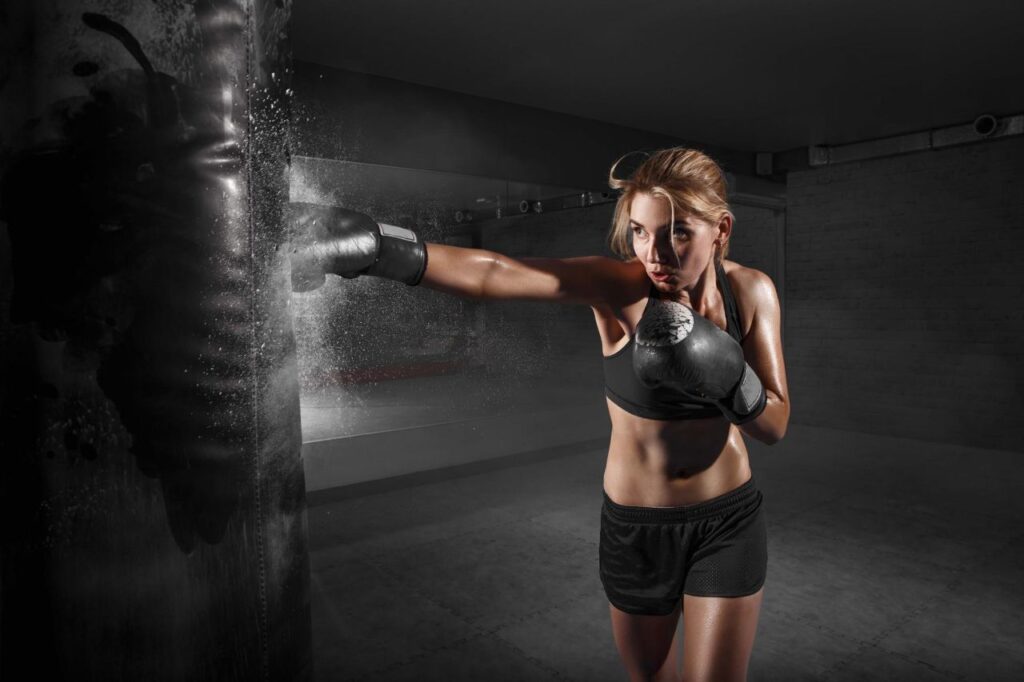If you’re looking for a full-body workout that’s both fun and challenging, boxing might be just what you need.
Not only does it improve your cardiovascular health and endurance, but it also helps you develop strength, speed, and agility.
However, before you start throwing punches, it’s important to learn the basic boxing movements.
The six basic boxing moves are the jab, cross, hook, uppercut, slip, and duck.
The jab is a quick, straight punch thrown with your lead hand, while the cross is a powerful punch thrown with your rear hand.
The hook is a circular punch thrown with your lead or rear hand, and the uppercut is an upward punch thrown with your lead or rear hand.
The slip is a defensive move where you move your head to the side to avoid a punch, and the duck is a defensive move where you bend your knees and lower your body to avoid a punch.
Before you start practicing these moves, make sure you have the right gear, including gloves, hand wraps, and a mouthguard.
It’s also a good idea to learn from a qualified instructor who can help you master the basics and avoid injury.
With practice and dedication, you can develop your boxing skills and enjoy the many benefits of this challenging sport.
Footwork
Footwork is one of the most important aspects of boxing. It is essential for maintaining balance, speed, and agility while executing techniques.

Stance
The first step to good footwork is to have a proper stance. Your feet should be shoulder-width apart, with your lead foot slightly forward.
If you are left-handed, your right foot should be forward, and if you are right-handed, your left foot should be forward. This is known as the orthodox stance.
If you are left-handed but have your right foot forward, this is known as the southpaw stance. Your knees should be slightly bent, and your weight should be evenly distributed between your feet.
Pivot
Pivoting is a crucial footwork technique used in boxing. It involves turning on the ball of your foot to change direction quickly.
This is useful for evading punches and changing angles of attack. To pivot, shift your weight to your back foot and turn on the ball of your front foot.
Lateral Movement
Lateral movement involves moving side to side while maintaining your fighting stance. This is useful for dodging punches and creating angles of attack.
To move laterally, step to the side with your lead foot, then bring your back foot over to meet it. Repeat in the opposite direction to move the other way.
Angles
Angles refer to the different directions you can move in while maintaining your fighting stance.
This is useful for creating openings in your opponent’s defense and setting up attacks. To move at an angle, pivot on the ball of your foot and step in the desired direction.
Punching Combinations
If you want to become a proficient boxer or kickboxer, then you need to master punching combinations.
Punching combinations are a sequence of punches that you throw in quick succession to hit your opponent and score points
Basic Combinations
Basic boxing punches include jabs, crosses, hooks, and uppercuts. These punches form the foundation of punching combinations.
Start by practicing each punch separately and then combine them to create basic combinations. For example, a basic combination can start with a jab followed by a cross or a hook.
Body shots are also an important part of basic punching combinations. Body shots can weaken your opponent and make them more vulnerable to head shots.
Incorporate body shots into your basic combinations to make them more effective.
Advanced Combinations
Once you have mastered the basic punching combinations, you can move on to advanced combinations.
Advanced combinations require more skill and energy, but they can also be more effective in the ring.
Some examples of advanced combinations include lead hooks followed by rear hooks or lead uppercuts followed by rear uppercuts.
To execute advanced combinations, you need to have good technique and hand speed. You also need to have strong hips and core to generate power and punching speed.
Incorporate strength and conditioning exercises into your workout routine to improve your punching speed and power.
Defensive Movements

When it comes to boxing, defense is just as important as offense.
Defensive movements help you avoid getting hit by your opponent, while also setting you up for counterattacks.
Slipping and Countering
Slipping is a technique where you move your head to the side to avoid a punch. This is usually followed by a counterpunch.
To slip, you need to pivot on your lead foot and move your head to the side. You can then counter with a punch to your opponent’s exposed side.
Rolling and Countering
Rolling is a technique where you move your upper body to avoid a punch. This is usually followed by a counterpunch.
To roll, you need to pivot on your lead foot and move your upper body to the side. You can then counter with a punch to your opponent’s exposed side.
Clinching
Clinching is a defensive technique where you grab onto your opponent’s body to prevent them from punching.
This is often used when you’re tired or hurt and need to take a break. Clinching can also be used to set up a takedown or throw.
Frequently Asked Questions
What are the different types of punches in boxing?
Boxing is all about punches, and there are several types of punches that boxers use in the ring. The most basic punches include the jab, cross, hook, and uppercut.
The jab is a quick, straight punch that is used to keep the opponent at bay. The cross is a powerful punch that is thrown with the rear hand.
The hook is a looping punch that is thrown with the lead hand. The uppercut is an upward punch that is thrown with either hand.
What are some advanced boxing techniques for punching?
Once you have mastered the basic punches, you can start to learn some advanced techniques. One such technique is the feint, which is a fake punch that is used to trick the opponent into lowering their guard.
Another advanced technique is the counterpunch, which is a punch that is thrown in response to an opponent’s punch. The slip is another advanced technique that involves moving your head to avoid an opponent’s punch.
How do boxers train to improve their punching?
Boxers train to improve their punching through a combination of strength training and technique drills.
Strength training helps to build the muscles that are used in punching, while technique drills help to improve the accuracy and speed of punches.
Boxers also use heavy bags, speed bags, and double-end punching bags to practice their punches.
What is the slugger boxing style and how does it differ from other styles?
The slugger boxing style is a style that is characterized by aggressive punching and a willingness to take punches in order to land punches.
This style is often used by boxers who have a lot of power but may not have as much speed or finesse.
The slugger style differs from other styles, such as the out-boxer style, which emphasizes speed and footwork, and the counter-puncher style, which involves waiting for the opponent to make a mistake before striking.
What is boxing movement and how is it used in the sport?
Boxing movement refers to the footwork and body positioning that boxers use to move around the ring.
Good boxing movement is essential for avoiding punches and setting up punches of your own.
Boxers use a variety of movements, such as the step-and-slide, the pivot, and the shuffle, to move around the ring.
What are some common boxing combinations that include punches?
Boxing combinations are sequences of punches that are used to set up an opponent and create openings for more powerful punches.
Some common combinations include the jab-cross, the jab-hook, and the hook-uppercut.
Boxers often practice these combinations on the heavy bag or with a sparring partner to improve their accuracy and speed.
